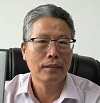SECOND-ORDER ITERATIVE METHOD FOR OPTIMAL CONTROL PROBLEMS OF MULTISTAGE PROCESSES
Abstract
The paper proposes a second-order strong improvement method for optimal control problems with non-fixed stage time intervals. The technique of inference algorithms is based on the theory of V. F. Krotov. Conditions are given for the control to be improvable, which are closely related to the necessary and sufficient conditions for a strong local minimum.
References
[1]V. A. Baturin and A. A. Lempert, Improvement method for discrete controlled system with network structure, Autom. Remote Control 72 (2011), 11-21.
[2]V. A. Baturin and D. E. Urbanovich, Approximate optimal control methods based on the extension principle, Science. Sib. Department, Novosibirsk, 1997, p. 175.
[3]K. N. Gabelko, Sequential improvement of multistage processes, Automation and Telemechanics 12 (1974), 72-80.
[4]V. I. Gurman, Expansion Principle in Management Tasks, Nauka, Moscow, 1997, p. 288.
[5]V. I. Gurman and A. G. Orlov, Sufficient conditions for optimality of complex processes, Automation and Telemechanics 4 (1978), 127-134.
[6]V. I. Gurman, V. A. Baturin and I. V. Rasina, Approximate Methods of Optimal Control, Irkutsk University Publishing House, Irkutsk, 1983, p. 180.
[7]V. I. Gurman, Degenerate Optimal Control Problems, Nauka, Moscow, 1977, p. 304.
[8]V. I. Gurman, I. V. Rasina, O. V. Fesko and O. V. Usenko, A method for improving control for hierarchical models of systems with a network structure, Izv. of Irkutsk State University. Ser. Maths., Vol. 8, 2014, pp. 71-85.
[9]V. I. Gurman and I. V. Rasina, Sufficient optimality conditions in hierarchical models of inhomogeneous systems, Automation and Telemechanics 12 (2013), 15-30.
[10]A. V. Dmitruk and A. M. Kaganovich, The maximum principle for optimal control problems with intermediate constraints, Nonlinear Dynamics and Control 6 (2008), 101-136.
[11]V. F. Krotov and V. I. Gurman, Optimal Control Methods and Problems, Nauka, 1973, p. 448.
[12]P. J. Antsaklis, A brief introduction to the theory and applications of hybrid systems, Proc. IEEE, Special Issue on Hybrid Systems: Theory and Applications 88(7) (2000), 879-886.
[13]R. Assard, M. A. Montecinob, A. Maasse and D. J. Sherman, Modeling acclimatization by hybrid systems: condition changes alter biological system behavior models, Biosystems 121 (2014), 43-53.
[14]M. S. Branicky, Multiple Lyapunov Functions and Other, Analysis Tools for Switched and Hybrid Systems, IEEE Trans. Automat. Control 43(4) (1998), 475-482.
[15]P.-Y. Chevalier, J. M. Hendrickx and R. M. Jungers, Efficient algorithms for the consensus decision problem, SIAM J. Control Optim. 53(5) (2015), 3104-3119.
[16]H. Haimovicha and M. M. Seron, Bounds and invariant sets for a class of switching systems with delayed-state-dependent perturbations, Automatica 49(3) (2013), 748-754.
[17]W. P. M. H. Heemels, B. De Schutter, J. Lunze and M. Lazar, Stability analysis and controller synthesis for hybrid dynamical systems, Phil. Trans. R. Soc. A 368 (2010), 4937-4960.
[18]D. Henrion, J. Daafouz and M. Claeys, Optimal switching control design for polynomial systems: an LMI approach, 52nd IEEE Conference on Decision and Control, 2013, pp. 1349-1354.
[19]Z. Li, Y. Soh and C. Wen, Switched and Impulsive Systems: Analysis, Design and Applications, Springer, Berlin, 2005, p. 271.
[20]D. Liberzon, Switching in Systems and Control, Springer, Berlin, 2003, p. 252.
[21]J. Lygeros, K. H. Johansson, S. N. Simic, J. Zhang and S. S. Sastry, Dynamical properties of hybrid automata, IEEE Trans. Automat. Control 48(1) (2003), 2-17.
[22]T. Monovich and M. Margaliot, Analysis of discrete-time linear switched systems: A variational approach, SIAM J. Control Optim. 49(2) (2011), 808-829.
[23]E. Santis, M. D. Benedetto, S. Gennaro, A. Innocenzo and G. Pola, Critical observability of a class of hybrid systems and application to air traffic management, Lecture Notes in Control and Information Sciences, Springer, N337, 2006.
[24]Y. Susuki and T. Hikihara, Predicting voltage instability of power system via hybrid system reachability analysis, American Control Conference, New York, 2007.
[25]A. V. Daneev, V. N. Sizykh and D. A. Palatov, Methodology of approximately optimal synthesis of fuzzy controllers according to the scheme of improvement and localization, Modern technologies. System analysis. Modeling No. 1 (2016), 103-112.





